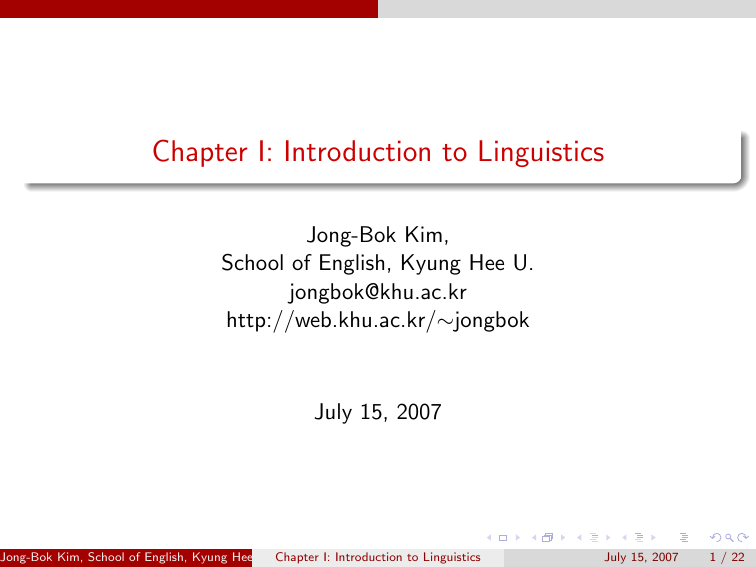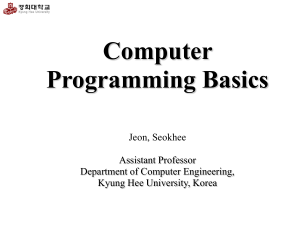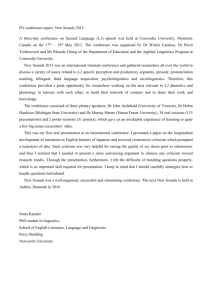Chapter I: Introduction to Linguistics
advertisement

Chapter I: Introduction to Linguistics Jong-Bok Kim, School of English, Kyung Hee U. jongbok@khu.ac.kr http://web.khu.ac.kr/∼jongbok July 15, 2007 Jong-Bok Kim, School of English, Kyung Hee U. jongbok@khu.ac.kr Chapter I: Introduction http://web.khu.ac.kr/∼jongbok to Linguistics () July 15, 2007 1 / 22 Introduction Who am I? Jong-Bok Kim (JB Kim) Entered KH in the 80s, went to the USA in 1991 for study, and get my Ph.D. in Linguistics in 1995. Research areas: syntax, semantics, morphology, computational linguistics in English and Korean What I will tell you a lot: Strong Body and Strong Mind, Study English for four hours a day, Use High Level English, etc... What I like most: sincere attitude, active attitude,... Easiest way to contact me: write email to me Center for Teaching and Learning: Global zone (English only zone), study group, tutoring, workshops, etc Jong-Bok Kim, School of English, Kyung Hee U. jongbok@khu.ac.kr Chapter I: Introduction http://web.khu.ac.kr/∼jongbok to Linguistics () July 15, 2007 2 / 22 Introduction Who are you? Name: Cell Phone: Email: High school and its location What I want to be: Anything that can impress JB? Things that you want to learn from this class: Jong-Bok Kim, School of English, Kyung Hee U. jongbok@khu.ac.kr Chapter I: Introduction http://web.khu.ac.kr/∼jongbok to Linguistics () July 15, 2007 3 / 22 What is Linguistics? What is Linguistics? (1) Q: WHAT IS LINGUISTICS? A: Linguistics is the systematic & scientific study of the nature and characteristics of human language and speech, and someone who engages in this study is called a linguist. Linguists are thus interested in understanding the properties common to all human languages through the study of linguistic structure (phonology, morphology, syntax, semantics) and language history, function, and acquisition. Linguists investigate similarities and differences between languages, how children and adults learn languages, and how we value and judge the speech and language usage of others. Jong-Bok Kim, School of English, Kyung Hee U. jongbok@khu.ac.kr Chapter I: Introduction http://web.khu.ac.kr/∼jongbok to Linguistics () July 15, 2007 4 / 22 What is Linguistics? What is Linguistics? (2) Linguistics belongs to the core of cognitive science, and is closely allied with many other disciplines such as anthropology, psychology, sociology, communication, speech therapy, education, computer science, philosophy, English, and foreign languages. Basic knowledge gained in linguistic study is applied to improve the understanding of language, language use, and language learning. In both theory and applications, linguistics can be viewed as the most scientific of the humanities and the most humanistic of the sciences. (from http://www.msu.edu/ linglang/linguistics/whatis.htm) Jong-Bok Kim, School of English, Kyung Hee U. jongbok@khu.ac.kr Chapter I: Introduction http://web.khu.ac.kr/∼jongbok to Linguistics () July 15, 2007 5 / 22 Some basic properties of Language Some key properties of language 1 Language codes information in arbitrary ways : One crucial function of language is to convey a great variety of information for communication. It uses sounds as its basic medium for information coding. Each sound is associated with a particular meaning by convention. One thing to note is that this relation between sounds and meanings is arbitrary. There is no systematic rule that can predict the relationship between speech sounds and the meanings they represent in the languages of the world. This is why we have to learn, for example, the sounds [don] in English represents ‘an action of putting something on’, but the same sounds in Korean means ‘money’.1 1 E.g., If you don clothing, you put it on. The crowd threw petrol bombs at the police, who responded by donning riot gear. Jong-Bok Kim, School of English, Kyung Hee U. jongbok@khu.ac.kr Chapter I: Introduction http://web.khu.ac.kr/∼jongbok to Linguistics () July 15, 2007 6 / 22 Some basic properties of Language Some key properties of language 2 Language is structured : Language, expressed by a sequence of sounds, in addition has words, phrases, and sentences. These elements all are built up from more basic elements according to some pattern. For example, in the example The man swims. the intuitive grouping is not [the [man swims]] but [[the man] swims]. When we hear Mary swims as a sequence of sounds [meri swim], we can figure out the sequence is structured as [[meri] [swim]] at least. A larger unit of language is thus built up from smaller units, forming a hierarchical structure. Jong-Bok Kim, School of English, Kyung Hee U. jongbok@khu.ac.kr Chapter I: Introduction http://web.khu.ac.kr/∼jongbok to Linguistics () July 15, 2007 7 / 22 Some basic properties of Language Some key properties of language (3) Language is rule-governed : The building process of the hierarchical structure is not a random one, but a rule-governed one. For example, given a set of words the, linguistics, study, students, how many English sentences can we have? We cannot combine these elements at our will, generating sentences like *The students linguistics study.; the result of the combination should be an English sentence as in The students study linguistics. We will see only a few word orders actually make English sentences. This property of language also applies to sounds. Jong-Bok Kim, School of English, Kyung Hee U. jongbok@khu.ac.kr Chapter I: Introduction http://web.khu.ac.kr/∼jongbok to Linguistics () July 15, 2007 8 / 22 Some basic properties of Language Some key properties of language (4) Language is innate, and creative : We are born with a capacity for language acquisition. That is, we are genetically equipped to learn a language. One amazing property of language comes from its ‘creativity’ (or productivity). We can understand a sentence that has neither spoken nor heard nor seen before. We could make a new sentence that has never existed before either in a spoken or written context. A proof is simple with the sentence Some sentences can go on and on. By adding and on to this sentence we can make a longer sentence Some sentences can go on and on and on.. We could add to this another and on again. Such a process can ‘go on’ endlessly. This in turn means that there is no limit to the number of sentences; we can generate as many sentences as possible. Jong-Bok Kim, School of English, Kyung Hee U. jongbok@khu.ac.kr Chapter I: Introduction http://web.khu.ac.kr/∼jongbok to Linguistics () July 15, 2007 9 / 22 Some basic properties of Language Some key properties of language (5) Language is uniquely human : Animal languages have a certain mode of communication and semantics attached to the symbols (sounds) they produce. However, they are different from human languages, in that they are iconic or ‘stimulus-bound’. There are neither innate nor creative. The relation between signals and meanings in the languages are not arbitrary. Animals have no discrete ability to divide a sentence or a sequence of sounds; to disseminate/segment complex parts into smaller parts. They have no productive (generative) ability to produce and understand any number of messages which have never been expressed before, etc. Jong-Bok Kim, School of English, Kyung Hee U. jongbok@khu.ac.kr Chapter I: Introduction http://web.khu.ac.kr/∼jongbok to Linguistics () July 15, 2007 10 / 22 What do you know when you know a language, for example, English Competence vs. performance When you know English, it means you have the knowledge of making grammatical English sentences. This in turn means you have the ability of speaking English perfectly. But when you are asked to state what this ‘knowledge’ is, it isn’t a simple task. We may not able to spell out even a sentence on this question. Most of us are unconscious of what this knowledge is. This unconscious ‘hidden’ knowledge is what we call linguistic competence. The linguistic competence is thus the potential of being able to speak a language. Since it is hard to recognize this competence knowledge and it is unavailable to our conscious thought, we look for its answers through the actual realization of our knowledge, which is linguistic performance. This linguistic competence is different from performance that reflects the actual use of language. Jong-Bok Kim, School of English, Kyung Hee U. jongbok@khu.ac.kr Chapter I: Introduction http://web.khu.ac.kr/∼jongbok to Linguistics () July 15, 2007 11 / 22 What do you know when you know a language, for example, English Phonetic/phonological competence: Sound System Phonetic Competence When one knows a language, it means he/she has basic knowledge of English sound systems. In particular, English speakers at least have the following phonetic competence: He or she can distinguish voiced and voiceless consonant sounds such as p vs. b, t vs. d, k vs. g (English). However, they cannot distinguish three Korean consonant sets such as k, kh, kk, unless they have studied the langauge. He or she knows what sounds are in that language and what sounds are not. For example, English doesn’t have the last sound of the word in ‘Bach’. He or she knows which sounds may start an English word and which aren’t. For example, the final sound of words like Bach, Nkrumah, sing, can not be used as the first sound of any English word. Jong-Bok Kim, School of English, Kyung Hee U. jongbok@khu.ac.kr Chapter I: Introduction http://web.khu.ac.kr/∼jongbok to Linguistics () July 15, 2007 12 / 22 What do you know when you know a language, for example, English Morphological Competence Morphological competence can decide which words are (can be) English and which are not. (1) *eatenun, *psapr, *bfli can segment the stream (the strings) of sounds into smaller meaningful units (2) looked, uncoffeelike, Ihavetogohomeearlytoday know the rules for forming words: Can you make the following as past tensed verbs? (3) email, fax, summer, winter Jong-Bok Kim, School of English, Kyung Hee U. jongbok@khu.ac.kr Chapter I: Introduction http://web.khu.ac.kr/∼jongbok to Linguistics () July 15, 2007 13 / 22 What do you know when you know a language, for example, English Syntactic Competence: Creativity Syntactic competence Can produce and understand the infinite number of new sentences that the speaker has never spoken, heard, written before. (4) All the students are feared of the class being taught in English, though this kind of class is much easier if taught in English. Can decide which strings of words are grammatical and which aren’t; have the rules for forming sentences and making the kinds of judgements on grammaticality. Rule-governed. (5) a. *The man the ball kicked. b. *Ball kicked man the c. The man kicked a ball (6) a. *Students fond of his introduction class. b. *This is the book that I gave it to John. Jong-Bok Kim, School of English, Kyung Hee U. jongbok@khu.ac.kr Chapter I: Introduction http://web.khu.ac.kr/∼jongbok to Linguistics () July 15, 2007 14 / 22 What do you know when you know a language, for example, English Syntactic Competence: Creativity Syntactic competence 2. Can generate an infinite number of sentences: (7) The man kicked the ball. (8) a. b. c. d. The tall man kicked the ball. The handsome, tall man kicked the ball. The handsome, tall, fat man kicked the ball. ..... (9) The old, old, old, old, old, old, old, and old man kicked the ball. (10) a. b. c. d. Some sentences can go on and on. Some sentences can go on and on and on. Some sentences can go on and on and on and on. ..... Jong-Bok Kim, School of English, Kyung Hee U. jongbok@khu.ac.kr Chapter I: Introduction http://web.khu.ac.kr/∼jongbok to Linguistics () July 15, 2007 15 / 22 What do you know when you know a language, for example, English Syntactic Competence: Creativity From creativity/rule-governed to generative grammar • Hypothesis 1: Native speakers memorize all these sentences (reactions to stimuli) • Hypothesis 2: Grammatical competence: (11) All native speakers have the grammatical competence that can generate an infinite set of English sentences with a finite set of device. • Generative Grammar: (12) An English generative grammar is the one that can generate an infinite set of well-formed English sentences with a finite set of rules or principles. Jong-Bok Kim, School of English, Kyung Hee U. jongbok@khu.ac.kr Chapter I: Introduction http://web.khu.ac.kr/∼jongbok to Linguistics () July 15, 2007 16 / 22 What do you know when you know a language, for example, English Semantic Competence Semantic/Pragmaitc competence Semantic competence can understand what makes sense and what doesn’t (13) I thought that Mary was ill, but it turned out that she wasn’t. !I realized that Mary was ill, but it turned out that she wasn’t. Pragmatic competence can interpret sentences depending on the context (14) Can you close the window? Jong-Bok Kim, School of English, Kyung Hee U. jongbok@khu.ac.kr Chapter I: Introduction http://web.khu.ac.kr/∼jongbok to Linguistics () July 15, 2007 17 / 22 Grammar Prescriptive vs. descriptive When we say language is rule-governed, it is different from the prescriptive rules or grammar. The prescriptive grammar tells us how to speak and write such as in the following: (15) a. Never end a sentence with a preposition b. Never split an infinitive (16) a. Where do you come from? b. He will try to boldly go where no one has gone before. The rule-governed grammar means a descriptive rule. The descriptive rule is the grammar of the language that exists in the minds of most of the native speakers. It is the basic linguistic knowledge shared by most of the speakers and existing in the minds of most of the native speakers. (17) a. S → NP, VP b. To form the plural of a noun, add ’s’ Jong-Bok Kim, School of English, Kyung Hee U. jongbok@khu.ac.kr Chapter I: Introduction http://web.khu.ac.kr/∼jongbok to Linguistics () July 15, 2007 18 / 22 Major Subfields of Linguistics Major subfields As we have seen, linguistics is the scientific study of language. It endeavours to answer the question–what is language and how it is structured. Linguistic structures are pairings of meaning and sound (or other externalization). Linguists may specialize in some subpart of the linguistic structure, which can be arranged in the following terms, from sound to meaning Jong-Bok Kim, School of English, Kyung Hee U. jongbok@khu.ac.kr Chapter I: Introduction http://web.khu.ac.kr/∼jongbok to Linguistics () July 15, 2007 19 / 22 Major Subfields of Linguistics Major subfields Phonetics: the study of the production and perception of speech sounds. It is concerned with the sounds of language, how these sounds are articulated and how the hearer perceives them. Phonology: the study of the sound patterns of language. It is concerned with how sounds are organized in a language. Morphology: the study of word formation and structure. It studies how words are put together from their smaller parts and the rules governing this process. Syntax: the study of sentence structure. It attempts to describe what is grammatical in a particular language in term of rules. Semantics: Semantics is the study of meaning. It is concerned with describing how we represent the meaning of a word in our mind and how we use this representation in constructing sentences. Semantics is based largely on the study of logic in philosophy. Jong-Bok Kim, School of English, Kyung Hee U. jongbok@khu.ac.kr Chapter I: Introduction http://web.khu.ac.kr/∼jongbok to Linguistics () July 15, 2007 20 / 22 Major Subfields of Linguistics Major subfields Pragmatics/Discourse: the study of meaning in context Language Acquisition: Language acquisition examines how children learn to speak and how adults learn a second language. Language acquisition is very important because it gives us insight in the underlying processes of language. Computational linguistics: application of linguistic knowledge into computer science Sociolinguistics: Sociolinguistics is the study of interrelationships of language and social structure, linguistic variation, and attitudes toward language. Neurolinguistics: Neurolinguistics is the study of the brain and how it functions in the production, perception and acquisition of language. Historical Linguistics: Historical linguistics is the study of language change and the relationships of languages to each other. Jong-Bok Kim, School of English, Kyung Hee U. jongbok@khu.ac.kr Chapter I: Introduction http://web.khu.ac.kr/∼jongbok to Linguistics () July 15, 2007 21 / 22 Homework Homework Read Chapter 1 of the textbook and do the exercises. Read the Essay ”Can animals learn language” and write a short summary or an essay (maximum two pages). Read Chapter 2 Jong-Bok Kim, School of English, Kyung Hee U. jongbok@khu.ac.kr Chapter I: Introduction http://web.khu.ac.kr/∼jongbok to Linguistics () July 15, 2007 22 / 22







